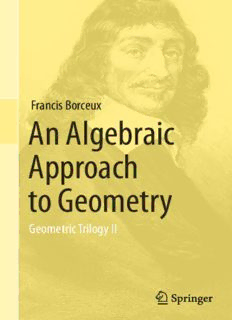
An Algebraic Approach to Geometry: Geometric Trilogy II PDF
Preview An Algebraic Approach to Geometry: Geometric Trilogy II
Francis Borceux An Algebraic Approach to Geometry Geometric Trilogy II An Algebraic Approach to Geometry Francis Borceux An Algebraic Approach to Geometry Geometric Trilogy II FrancisBorceux UniversitécatholiquedeLouvain Louvain-la-Neuve,Belgium ISBN978-3-319-01732-7 ISBN978-3-319-01733-4(eBook) DOI10.1007/978-3-319-01733-4 SpringerChamHeidelbergNewYorkDordrechtLondon LibraryofCongressControlNumber:2013953917 MathematicsSubjectClassification(2010): 51N10,51N15,51N20,51N35 ©SpringerInternationalPublishingSwitzerland2014 Thisworkissubjecttocopyright.AllrightsarereservedbythePublisher,whetherthewholeorpartof thematerialisconcerned,specificallytherightsoftranslation,reprinting,reuseofillustrations,recitation, broadcasting,reproductiononmicrofilmsorinanyotherphysicalway,andtransmissionorinformation storageandretrieval,electronicadaptation,computersoftware,orbysimilarordissimilarmethodology nowknownorhereafterdeveloped.Exemptedfromthislegalreservationarebriefexcerptsinconnection with reviews or scholarly analysis or material supplied specifically for the purpose of being entered and executed on a computer system, for exclusive use by the purchaser of the work. Duplication of this publication or parts thereof is permitted only under the provisions of the Copyright Law of the Publisher’slocation,initscurrentversion,andpermissionforusemustalwaysbeobtainedfromSpringer. PermissionsforusemaybeobtainedthroughRightsLinkattheCopyrightClearanceCenter.Violations areliabletoprosecutionundertherespectiveCopyrightLaw. Theuseofgeneraldescriptivenames,registerednames,trademarks,servicemarks,etc.inthispublication doesnotimply,evenintheabsenceofaspecificstatement,thatsuchnamesareexemptfromtherelevant protectivelawsandregulationsandthereforefreeforgeneraluse. Whiletheadviceandinformationinthisbookarebelievedtobetrueandaccurateatthedateofpub- lication,neithertheauthorsnortheeditorsnorthepublishercanacceptanylegalresponsibilityforany errorsoromissionsthatmaybemade.Thepublishermakesnowarranty,expressorimplied,withrespect tothematerialcontainedherein. Coverimage:RenéDescartes,etching1890afterapaintingbyFransHals,artistunknown Printedonacid-freepaper SpringerispartofSpringerScience+BusinessMedia(www.springer.com) To François, Sébastien,Frédéric, Rachel,EmmanuelandLudovic Preface Thereaderisinvitedtoimmersehimselfina“lovestory”whichhasbeenunfolding for35centuries:thelovestorybetweenmathematiciansandgeometry.Inaddition toaccompanyingthereaderuptothepresentstateoftheart,thepurposeofthisTril- ogyispreciselytotellthisstory.TheGeometricTrilogywillintroducethereaderto themultiplecomplementaryaspectsofgeometry,firstpayingtributetothehistorical work on which it is based, and then switching to a more contemporary treatment, making full use of modern logic, algebra and analysis. In this Trilogy, Geometry isdefinitelyviewedasanautonomousdiscipline,neverasasub-productofalgebra or analysis. The three volumes of the Trilogy have been written as three indepen- dent but complementary books, focusing respectively on the axiomatic, algebraic and differential approaches to geometry. They contain all the useful material for a wide range of possibly very different undergraduate geometry courses, depending onthechoicesmadebytheprofessor.Theyalsoprovidethenecessarygeometrical background for researchers in other disciplines who need to master the geometric techniques. Itisamatteroffactthat,formorethan2000years,theGreekinfluenceremained so strong that geometry was regarded as the only noble branch of mathematics. In [7], Trilogy I, we have described how Greek mathematicians handled the basic algebraic operations in purely geometrical terms. The reason was essentially that geometricquantitiesaremoregeneralthannumbers,sinceatthetime,onlyrational numberswererecognizedasactualnumbers.Inparticular,algebrawasconsidered as a “lower level art”—if an “art” at all. Nevertheless, history provides evidence thatsomemathematicianssometimesthought“inalgebraicterms”;butelegancere- quiredthatthefinalsolutionofaproblemalwayshadtobeexpressedinpurelygeo- metricalterms.Thisattitudepersisteduptothemomentwheresomedaringmathe- maticianssucceededincreatingelegantandpowerfulalgebraicmethodswhichwere abletocompetewiththeclassicalsyntheticgeometricapproach.Unexpectedly,itis togeometrythatthisnewapproachhasbeenmostprofitable:awiderangeofnew problems, in front of which Greek geometry was simply helpless, could now be stated and solved. Let us recall that Greek geometry limited itself to the study of thoseproblemswhichcouldbesolvedwithrulerandcompassconstructions! vii viii Preface Duringthe17thcentury,FermatandDescartesintroducedthebasicconceptsof analyticgeometry,allowinganefficientalgebraicstudyoffunctionsandcurves.The successesofthisnewapproachhavebeenstriking.However,astimewenton,and theproblemsstudiedbecamemoreandmoreinvolved,thealgebraiccomputations neededtosolvetheproblemswerethemselvesbecomingsoinvolvedandheavyto handlethattheyhadlostalltracesofelegance.Clearly,thelimitsofthisalgebraic approachhadmoreorlessbeenreached. Butforthosemenbelievingintheirart,adifficultytakingtheformofadeadend isjusttheoccasiontoopennewwaystounexpectedhorizons.Thisiswhathappened duringthe19thcentury,withthebirthofabstractalgebra.Thetheoryofgroups,that ofvectorspaces,thedevelopmentofmatrixalgebraandtheabstracttheoryofpoly- nomialshaveprovidednewefficienttoolswhich,today,remainamongthekeyin- gredientsinthedevelopmentofanalgebraicapproachtogeometry.Grothendieck’s theory of schemes is probably the most important new stone that the 20th century offered to algebraic geometry, but this is rather clearly beyond the scope of this introductorytext. We devote the first chapter of this book to an historical survey of the birth of analytic geometry, in order to provide the useful intuitive support to the modern abstractapproach,developedinthesubsequentchapters. Thesecondchapterfocusesonaffinegeometryoveranarbitrary(alwayscommu- tative)field:westudyparallelsubspaces,parallelprojections,symmetries,quadrics andofcourse,thepossibleuseofcoordinatestotransformageometricprobleminto analgebraicone. The three following chapters investigate the special cases where the base field is that of the real or complex numbers. In real affine spaces, there is a notion of “orientation”whichinparticularallowsustorecapturethenotionofasegment.The Euclidean spaces are the real affine spaces provided with a “scalar product”, that is, a way of computing distances and angles. We pay special attention to various possible applications, such as approximations by the law of least squares and the Fourierapproximationsofafunction.WealsostudytheHermitiancase:theaffine spaces, over the field of complex numbers, provided with an ad hoc “scalar (i.e. Hermitian)product”. Returningtothecaseofanarbitraryfield,wenextdevelopthetheoryofthecor- respondingprojectivespacesandgeneralizevariousresultsprovedsyntheticallyin [7],TrilogyI:thedualityprinciple,thetheoryoftheanharmonicratio,thetheorems ofDesargues,Pappus,Pascal,andsoon. Thelastchapterofthisbookisafirstapproachtothetheoryofalgebraiccurves. Welimitourselvestothestudyofcurvesofanarbitrarydegreeinthecomplexpro- jectiveplane.Wefocusonquestionssuchastangency,multiplepoints,theBezout theorem,therationalcurves,thecubics,andsoon. Each chapter ends with a section of “problems” and another section of “exer- cises”.Problemsaregenerallystatementsnottreatedinthisbook,butoftheoretical interest,whileexercisesaremoreintendedtoallowthereadertopracticethetech- niquesandnotionsstudiedinthebook. Preface ix Ofcoursereadingthisbooksupposessomefamiliaritywiththealgebraicmeth- odsinvolved.Roughlyspeaking,weassumeareasonablefamiliaritywiththecon- tentofafirstcourseinlinearalgebra:vectorspaces,bases,linearmappings,matrix calculus,andsoon.Wefreelyusethesenotionsandresults,sometimeswithavery briefreminderforthemoreinvolvedofthem.Wemaketwonotableexceptions.First thetheoryofquadraticforms,whosediagonalizationappearstobetreatedonlyin therealcaseinseveralstandardtextbooksonlinearalgebra.Sincequadraticforms constitutethekeytoolfordevelopingthetheoryofquadrics,webrieflypresentthe results we need about them in an appendix. The second exception is that of dual vectorspaces,oftenabsentfromafirstcourseinlinearalgebra. Inthelastchapteronalgebraiccurves,thefactthatthefieldCofcomplexnum- bersisalgebraicallyclosedisofcourseessential,asisthetheoryofpolynomialsin severalvariables,includingthetheoryoftheresultant.Thesetopicsarecertainlynot partofafirstcourseinalgebra,evenifthereadermaygetthe(false)impressionthat many of the statements look very natural. We provide various appendices proving these results in elementary terms, accessible to undergraduate students. This is in particularthecase for theproof thatthe fieldof complexnumbersis algebraically closedandfortheuniquefactorizationinirreduciblefactorsofapolynomialinsev- eralvariables. Aselectivebibliographyforthetopicsdiscussedinthisbookisprovided.Certain items,nototherwisementionedinthebook,havebeenincludedforfurtherreading. Theauthorthanksthenumerouscollaboratorswhohelpedhim,throughtheyears, toimprovethequalityofhisgeometrycoursesandthusofthisbook.Amongthem he especially thanks Pascal Dupont, who also gave useful hints for drawing some oftheillustrations,realizedwithMathematicaandTikz. The Geometric Trilogy I.AnAxiomaticApproachtoGeometry 1. Pre-Hellenicantiquity 2. SomePioneersofGreekGeometry 3. Euclid’sElements 4. SomeMastersofGreekGeometry 5. Post-HellenicEuclideanGeometry 6. ProjectiveGeometry 7. Non-EuclideanGeometry 8. Hilbert’sAxiomatizationofthePlane Appendices A. Constructibility B. TheThreeClassicalProblems C. RegularPolygons II.AnAlgebraicApproachtoGeometry 1. ThebirthofAnalyticGeometry 2. AffineGeometry 3. MoreonRealAffineSpaces 4. EuclideanGeometry 5. HermitianSpaces 6. ProjectiveGeometry 7. AlgebraicCurves Appendices A. PolynomialsoveraField B. PolynomialsinSeveralVariables C. HomogeneousPolynomials D. Resultants E. SymmetricPolynomials F. ComplexNumbers xi xii TheGeometricTrilogy G. QuadraticForms H. DualSpaces III.ADifferentialApproachtoGeometry 1. TheGenesisofDifferentialMethods 2. PlaneCurves 3. AMuseumofCurves 4. SkewCurves 5. LocalTheoryofSurfaces 6. TowardsRiemannianGeometry 7. ElementsofGlobalTheoryofSurfaces Appendices A. Topology B. DifferentialEquations
Description: